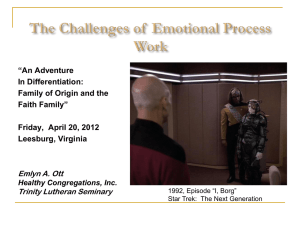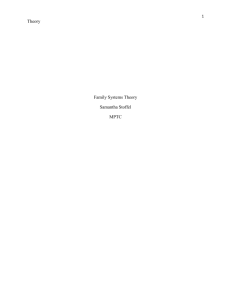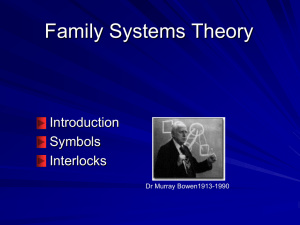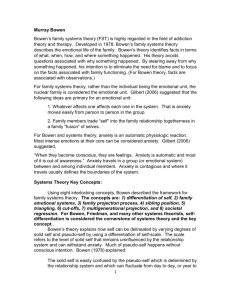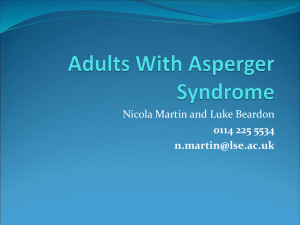A Family Systems Approach to Congregational Life
advertisement
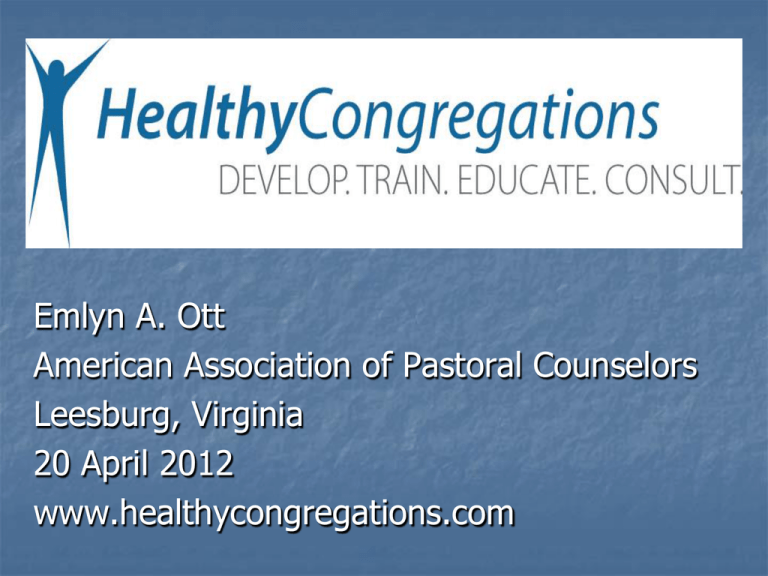
Emlyn A. Ott American Association of Pastoral Counselors Leesburg, Virginia 20 April 2012 www.healthycongregations.com Family Systems Theory Is Not for the Faint of Heart Family Systems for the Leader, Their Family and Congregation 101 Or… Family Systems Theory 1001 Or both…. Equipping, Challenging, Clarifying with Grace…. Who Was Murray Bowen? Psychiatrist who was trained in traditional psychoanalytic model who became convinced that the impact of the family and multigenerational family process stirs the presence of “symptoms” in each generation; focusing on individual pathology did not lead to increasing ability for humans to function deeply and fully. Studied families with schizophrenic members first at Menninger and then at NIH. Leader in the “family movement” which led to many different approaches to family systems theory in the 50’s and the 60’s. Developed a theory that considered eight concepts and two life forces as being important to looking at families and groups of people who find themselves together for a purpose. Made use of observation and scientific language to describe the natural processes associated with human life Contributions led to the development of what is now called “Bowen theory” or “natural systems theory” Continued research done at The Bowen Center for the Study of the Family (www.thebowencenter.org) What Do You Know About Bowen Theory or Natural Systems? Eight Concepts – triangles, cut-off, sibling position, differentiation of self, nuclear family emotional process, family projection process, multigenerational family process, societal emotional process Two Life Forces – anxiety and closeness/distance A Ninth Concept – spirituality Further Research on the concept of the “Unidisease” Impact of Bowen theory on religious communities and organizational life Natural Systems Observation Who and what gets worried about (family projection process) When relationships get wobbly, what happens and are those relationships stuck (triangles) How do relationships between siblings and parents create expectations and dynamics (sibling position) What patterns and emotions seem to be carried on in multiple generations (multigenerational transmission process) How does anxiety and togetherness function (emotional system) Where is there no contact with ideas or people (cutoffs) How well are family members functioning with their whole selves (differentiation) What is the impact of societal pressures (emotional process in society) @Emlyn A. Ott, 2010 For the Birds 2001 Academy Award Winner for Best Animated Short What do you observe? Common Tricky Understandings (Fallacies???) Systems theory is about leadership Systems theory is about managing conflict Systems theory is about managing change Busyness is the same as overfunctioning Talking to another person is the same as “staying connected” Systems theory is about getting out of triangles The leader’s job is to lower systemic anxiety And an extremely tricky concept… Non-anxious presence…. Do we confuse this concept with an “Anxious Absence?” The only time that we are truly without some form of anxiety is…… when we are dead. A General Systems Approach: 1. 2. 3. What’s So Unique About Systems Thinking? Movement away from cause and effect thinking. All things/beings are related. Everything is multi-causal General Systems and Natural Systems Yes! There is a difference! General Systems Theory is used for organizational understanding and to encourage us to think bigger and outside of our comfort zone. Natural Systems Theory/Emotional Process understanding looks at the unique structure that has been created in us that encourages the challenge between closeness and separation—called one of the “life forces” by Murray Bowen. By observing created life, we have a view of those processes and relationships that are a part of the world and a perspective on a Holy Other and belief systems as well “For the Birds” Animated short which won the Academy Award in its category in 2001 Included on the “Monsters Inc.” DVD. Pixar has created some profound and thoughtful pieces of work! Ability to observe natural process in a variety of venues The Core Concept: Differentiation Courage to define self… invested in the welfare of the family or organization AND self, neither angry nor dogmatic…energy goes to changing self rather than telling others what they should do…knows and respects the multiple opinions of others…can modify self in response to the strengths of the groups… not influenced by the irresponsible opinions of others. Murray Bowen Differentiation According to Rabbi Edwin Friedman It is the lifelong process of striving to keep one’s being in balance through the reciprocal external and internal processes of self definition and self regulation. It means the capacity to become oneself out of oneself with minimum reactivity to the positions or reactivity of others—while staying connected. Being able to live in your own skin more and more of the time. Anxiety and Responsibility Anxiety exists in all relationships. Anxiety is created as beings deal with the tension of the life forces of closeness and separation. Anxiety propels the “F words”: fight, flight, freeze, fuse, frenzy, fornicate Karen Armstrong adds another “F word” What brings anxiety and responsibility together? How anxiety is handled. Moving toward thoughtfulness. Extraordinary Relationships Thinking systems, watching process (Roberta Gilbert) The ideal: separate, equal and open “Emotions are the intense reactivities, both physiologically and mental, including the instincts, that are generated in the part of the brain that humans share, anatomically and functionally, with the rest of the animal kingdom.”(page 38) Five familiar and well-defined relationship patterns: A. Conflict B. Distance C. Cut-off D. Dysfunctional Spouse (also called overfunctioning/underfunctioning reciprocity) E. Dysfunctional child (also called triangling) Extraordinary Relationships in the Bible – Why are faith community leaders drawn to family systems? Differences in Systems/Congregations The need for comfort and challenge is inherent in the human being and in any organization where human beings gather. How can differentiation of self be encouraged in communities of faith? Concepts of fusion and cut-off – both are responses to anxiety and the problem of being a self and having closeness with others. Focusing on Strength All congregations face times of testing, difficulty and conflict. Conflict is not good or bad—it is the process of dealing with it that is instructive. Focusing on process can encourage the strengths of individuals and the corporate body. Strength means keeping in mind the issues, being aware of the emotional reactions, working on not reacting BACK, and focusing on hope and “promise” in the midst of community challenges. Key to the Kingdom? The ability to deal with resistance while staying on course. Resistance truly threatens the leader’s lifelong process of differentiating a self. “Resistance is the greatest gift of the whole process.” Learning How to Be Able to Be More Objective Draw a picture Move into an observer role Stay in the dance! Conversation Time Process: each speak without interruption or questions Talk about your position in your family. In what ways do you understand how you respond to anxiety in yourself or others; and how do you manage “closeness and separateness” with family and friends.

